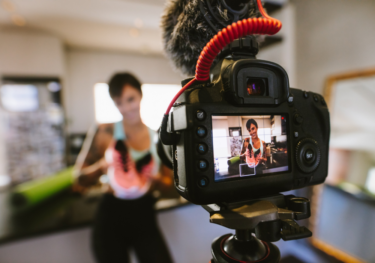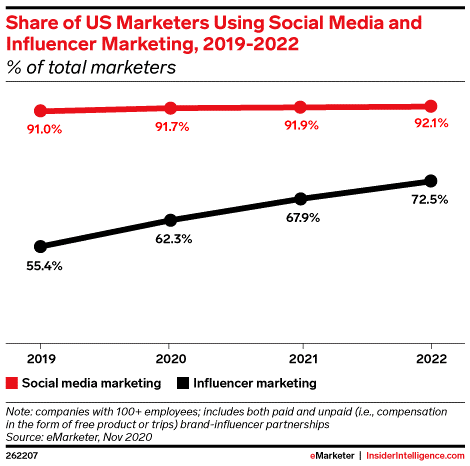Blog | 21 Jun 2021
Social media influencers get real—and big brands are following

Sundus Alfi
Senior Editor, Thought Leadership

It has been a tough few years for truth, trust, and authenticity online. Between a global pandemic and broader social, political, and economic unrest, social media influencers—and the brands they work with—found themselves under strict scrutiny from their audiences, expected to balance the responsibilities of influencing with the realities around them. Yet despite the turbulence, these influencers have persevered and even thrived—and will almost certainly continue to do so into the future.
Influencers have become an important voice on a wide range of topics, from reviewing and recommending consumer goods to giving advice on housecleaning and entrepreneurship. But as their numbers have swelled, so have questions about their integrity and value to consumers.
While the term “influencer” was only recently added to the Merriam-Webster Dictionary, influencer marketing—in which organizations and companies work with popular personalities to promote and sell a product or service—is a centuries-old practice. Unlike traditional celebrity endorsements, however, today’s influencers can be anyone with an engaged online following. (Yes, that includes CGI influencers like Miquela Sousa.) Their sway can be highly powerful: the top social media influencers have millions of followers.

It’s no wonder, then, that the share of marketers working with social media influencers is quickly catching up to traditional social media marketing; eMarketer forecasts that nearly three-quarters expect to use influencer marketing by 2022. According to Influencer Marketing Hub’s 2021 benchmarking report, 62% of marketers who spend on influencers planned to increase their budget in 2020, and 75% intended to dedicate a budget for influencer marketing in 2021.
But much like any other trade, influencer marketing is sensitive to evolving consumer demands and expectations.
In the earlier days of social media influencing, posts on platforms such as Instagram were highly curated to communicate perfection. The message was that influencers were not just “ordinary people” struggling with everyday issues—they were healthy, beautiful, well-traveled, popular, and ultra-happy. The implication for their followers, of course, was that this life was attainable, and only a few purchases away. It was not immediately clear that these product and service endorsements were sponsored by brands, an issue that has persisted despite the Federal Trade Commission’s guidelines around influencer marketing. These posts are not harmless: studies have found that social media use can exacerbate mental health and well-being as people compare themselves with these personas.
During the pandemic and resulting lockdown, with nowhere to go and no one to see, many people—particularly Gen Z—turned to social media for a sense of community. Not surprisingly, they quickly found this picture-perfect façade to lack the honesty of the wider global reality.
Before long, a new generation of influencers had emerged—especially on the video-sharing platform TikTok, where many made fun of the superficiality often associated with influencing and instead embraced sharing their unfiltered life experiences. Other trends caught on, too: influencers opened up about the toxicity of influencing, and calls for a more genuine social media experience (e.g., the Make Instagram Casual Again movement) gained attention.
The need for authentic, relatable content led brands to play catch-up. From unretouched beauty campaigns to more inclusive model castings, influencing cannot continue to be the manufactured industry it was in the early 2010s.
Ultimately, the value influencers bring to brands is only as strong as the connection they foster with their audience, and engagement between influencers and their followers is no longer limited to passive Instagram photos and one-to-many YouTube videos. Influencers have a growing host of community-oriented tools at their disposal, including live videos, fundraising features, stories that disappear in 24-hours, tip jars, short-form videos (e.g., TikTok, Instagram Reels, YouTube Shorts), subscription-based platforms (e.g., Patreon, Substack), and more.
These features not only give influencers more freedom when it comes to their content creation, it keeps audiences interested and helps build the trust and sense of connection they feel with influencers—thereby reducing the sponsored content fatigue that thwarts engagement.
Social media influencers are still creating their medium. With company spending in this area rapidly increasing and big tech continuously rolling out new features, the future of influencing is promising. Still, the industry will have to continually confront demands for authenticity and transparency if it is to uphold social media’s promise to connect people.
Tags:
You may be interested in

Post
Industry key themes 2026: Industry will grow if you know where to look
Prospects appear solid for global industry in 2026, but activity is set to remain regionally and sectorally divergent.
Find Out More
Post
Silver, the next generation metal
This report highlights the critical role silver plays in data centres and artificial intelligence (AI), automotive and electric vehicles (EVs), and solar energy photovoltaics (PVs). With these sectors expected to expand significantly over the coming years, we expect future silver demand to be strong.
Find Out More
Post
Powering the UK Data Boom: The Nuclear Solution to the UK’s Data Centre Energy Crunch
The UK’s data centre sector is expanding rapidly as digitalisation, cloud computing, and artificial intelligence (AI) drive surging demand for high-performance computing infrastructure.
Find Out More